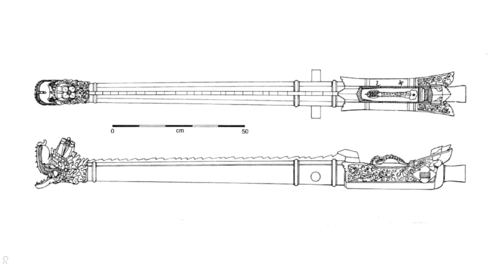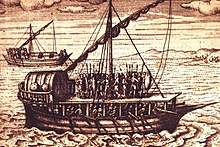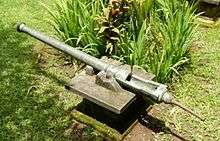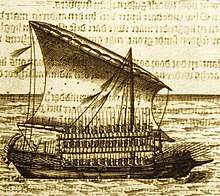Cetbang

The Cetbang was a type of cannon produced and used by the Majapahit Empire (1293–1527) and other kingdoms in the Nusantaran archipelago.
The cetbang differed from typical European and Middle Eastern cannons, such as the muzzleloader, in that it was made from bronze, and was a breech-loading cannon. In the Sekar inscription it states that the main production foundries of cetbang were in Rajakwesi, Bojonegoro, whereas the black powder was produced in Swatantra Biluluk.[1]
Several examples survive and are exhibited as tourist attractions or in museums.
Usage in the Majapahit era

Cannons were thought to have been introduced to Majapahit when Kublai Khan's Chinese army under the leadership of Ike Mese sought to invade Java in 1293. The Majapahit Kingdom dominated the Nusantaran archipelago primarily because it possessed the technology to cast and forge bronze on an early mass production basis. The Majapahit also pioneered the manufacturing and usage of firearms on a large scale. The Majapahit Empire was one of the last major empires of the region and is considered to be one of the most powerful empires in the history of Indonesia and Southeast Asia.
The use of cannons was widespread in the Majapahit navy, amongst pirates, and in neighboring kingdoms in Nusantara.[2] The size of cetbang used by the Majapahit navy varied from one to three meters in length. The three-meter-long cetbang was usually used by the larger ships in the Majapahit navy (see Djong). A famous Majapahit admiral, Mpu Nala, was renowned for his use of cannons. Records of Mpu Nala are known from the Sekar inscription, the Mana I Manuk (Bendosari) inscription, the Batur inscription, and the Tribhuwana inscription which referred to him as Rakryan Tumenggung (war commander).[3]
Cetbang can be mounted as fixed or swivel gun, small sized cetbang can be easily installed on small vessels called Penjajap (Portuguese: Pangajaua or Pangajava) and Lancaran. This gun is used as an anti-personnel weapon, not anti-ship. In this age, even to the 17th century, the Nusantaran soldiers fought on a platform called Balai (see picture of ship below) and perform boarding actions. Loaded with scattershot and fired at close range, the cetbang is very effective at this type of fighting.[4]
Usage after the Majapahit era

Following the decline of the Majapahit, and the consequent decline in demand for firearms, many weapon makers and bronze-smiths moved to Sumatra, the Malay peninsula, or the Philippines. This spread the production and usage of the cetbang, especially for protecting trade ships in the Makassar Strait from pirates. When the Portuguese first came to Malacca, they found a large colony of Javanese merchants under their own headmen; the Javanese were manufacturing their own cannon, which then, and for long after, were as necessary to merchant ships as sails.[5] Majapahit-era cetbang cannons were further improved and used in the Demak Sultanate period during the Demak invasion of Malacca. During this period, the iron, for manufacturing Javanese cannons was imported from Khorasan in northern Persia. The material was known by Javanese as wesi kurasani (Khorasan iron).
When the Portuguese came to the archipelago, they referred to it as Berço, which was also used to refer to any breech-loading swivel gun, while the Spaniards call it Verso.[4] In the period after the Majapahit decline, cannons derived from cetbang in Nusantara (especially from Sumatra and the Malay area) were grouped into two types :
- Lela
- The lela was smaller in size compared to 16th century European cannons and usually had intricate patterning. They were used mainly by Malay sultanates in the Malay peninsula, Sumatra, and Kalimantan. Lela cannons were used on trade ships and warships to ward off pirates. The lela was also fired ceremoniously, for instance upon the enthroning of kings, when receiving guests, at engagement ceremonies, and to pay respects for a death.
- Rentaka
- A rentaka is a swivel gun with smoothbore barrel, and is muzzle loaded. Rentaka, or lantaka, is a term in Malay for cannons smaller in caliber than lela, with a long barrel and made from iron. This term was created to differentiate these smaller cannons from lela. They were mainly used in the 16th, 17th, and 18th centuries, though Filipinos were still using rentaka during the Philippine–American War of 1899–1902.
Surviving examples

There are surviving examples of the cetbang at:
- The Bali Museum, Denpasar, Bali. This Balinese cannon is located in the yard of Bali Museum.
- The Metropolitan Museum of Art, New York, USA. This cannon is thought to have been produced in the 14th century, made from bronze with dimensions of 37.7 inches (96 cm) x 16 inches (41 cm).[6]
- Luis de Camoes museum in Macau has a piece of highly ornamented cetbang. Year manufactured is unknown.
- Talaga Manggung museum, Majalengka, West Java. Numerous cetbang is in good condition due to routine cleaning ritual.[7]
- A 4-wheeled cetbang can be found at Istana Panembahan Matan in Mulia Kerta, West Kalimantan.[8]

Majapahitan cetbang are also found at:
- Dundee beach, Northern Territory, Australia. Researchers have concluded that this bronze swivel cannon is from the 16th century, before James Cook's voyage to Australia. The model is closer to the Ternate, Makassar, or Balinese cannons.[9]
- Bissorang village, Selayar islands, Sulawesi Selatan province. This cannon is thought to have originated from the Majapahit era. Local people call this cetbang Ba'dili or Papporo Bissorang.[10]
- A Mataram-era (1587–1755) cetbang can be found at Lubuk Mas village, South Sumatera, Indonesia.[11]
See also
References
- ↑ Dr. J.L.A. Brandes, T.B.G., LII (1910)
- ↑ Apoorv shelke, Kalpesh Khatavkar, Nikhil Rane & Paresh Patil. The Bullet : Contains all basic Information. PediaPress.
- ↑ "PRASASTI SEKAR". penyuluhbudayabojonegoro.blogspot.co.id. Retrieved 2017-08-06.
- 1 2 Reid, Anthony (2012). Anthony Reid and the Study of the Southeast Asian Past. Institute of Southeast Asian Studies. ISBN 978-981-4311-96-0.
- ↑ Furnivall, J.S. Netherlands India: A Study of Plural Economy. h.9.Cambridge University Press (2010)."when Portuguese first came to Malacca they noticed a large colony of Javanese merchants under its own headman; the Javanese even founded their own cannon, which then, and for long after, were as necessary to merchant ships as sails."
- ↑ "Cannon | Indonesia (Java) | Majapahit period (1296–1520) | The Met". The Metropolitan Museum of Art, i.e. The Met Museum. Retrieved 2017-08-06.
- ↑ "Museum Talaga Manggung-Dinas Pariwisata dan Kebudayaan Provinsi Jawa Barat". www.disparbud.jabarprov.go.id. Retrieved 2018-06-30.
- ↑ Rodee, Ab (11 August 2017). "Meriam Melayu". Picbear. Retrieved 16 July 2018.
- ↑ Clark,Paul. Dundee Beach Swivel Gun : Provenance Report. Department of Arts & Museum NTG, 2015.
- ↑ "kabarkami.com Is For Sale". www.kabarkami.com. Retrieved 2017-08-06.
- ↑ Rawas, Sukandar. "Meriam kuno Lubuk Mas". Youtube.
